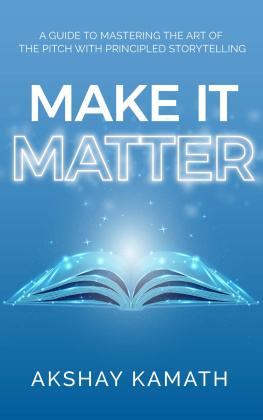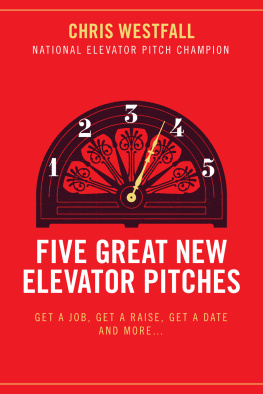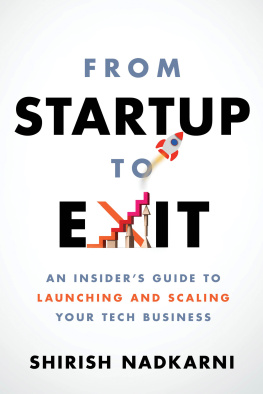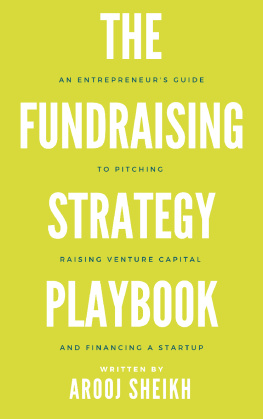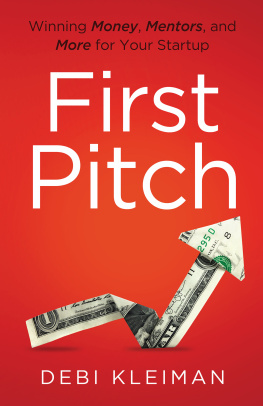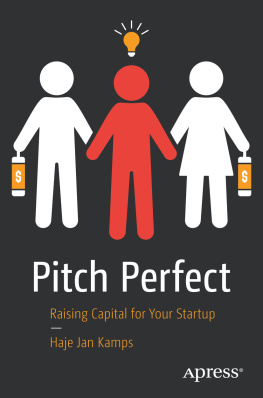The Startup Pitch

THE STARTUP PITCH
Copyright 2013 by Chris Lipp.
All rights reserved. No part of this book may be used or reprinted, in any form or by any electronic or mechanical means, including information storage and retrieval systems, without permission by the author, except for brief quotations by reviewers.
Published by PowerSpeech, Mountain View, Ca.
For more information, contact
Version 1.1
www.pitchpower.org
Cover art designed by Sonia Oster
To my parents Mandy and Bob,
for teaching me the two real skills of life:
love and independence.
Contents
Forward
As an entrepreneur you will be asked to do many things, but none as hair-raising as that moment you are asked to deliver a pitch. Thats when the rubber meets the road and you must share your idea with others who can help you succeed. Those few minutes are crucial.
Chris Lipp is an entrepreneur with a proven framework for pitching and a passion for helping fellow entrepreneurs tell their story. He has given all of us a gift by investing thousands of hours creating this primer for pitching which you are now holding in your hands (or reading on your kindle). He transparently shares his own failures and successes as an entrepreneur in the trenches trying to communicate to potential investors. But more than that, he has coached hundreds of fellow entrepreneurs, and interviewed and researched still more. In short, Chris Lipp has invested his time to understand pitching so all of us can benefit.
I urge you to buy The Startup Pitch , read it, and use it. This book (much like the method Chris will detail for you) meets a unique need in the marketplace. Hes recognized that while other authors provide laundry lists of what to include, none shares a memorable, codified approach to guide the pitch itself. His approach is for you to embrace and use as you further your start-up pitching to potential investors.
Chris approach is rapid fire, exactly what I find my students expect. Todays entrepreneurs are used to moving fast and adjusting on the go. In fact I have already sketched out his model for pitching numerous times with my own students to illustrate the key goals of a pitch. So I suggest you devour the book in short order, flagging items you want to revisit. Grasp the simplicity of Chris 4-Point Formula and how your idea can be served by communicating in this way. Then, return to the book at a more leisurely pace as you build or refine your pitch. My prediction for this book is that dog-eared copies will make the rounds of incubators, shared work spaces, and dorm rooms as aspiring entrepreneurs begin to see the value in what Chris has created.
As Ive read his drafts through the past year, Ive seen the model emerge with greater clarity, much like the old Polaroid photographs that slowly appeared before your eyes (yeah, Im dating myself now as a baby boomer.) Now Chris is ready to share it with all of you. The real gift is not the book, but what you do with it. The Startup Pitch written by an entrepreneur for entrepreneurs directly reflects the task you face preparing a pitch.
JD Schramm, Ed.D.
Founder, Mastery in Communication Initiative
Stanfords Graduate School of Business
Chapter 1
Real Rules
When CEO Howard Schultz hit the road to pitch Starbucks, he was rejected by over 200 investors. Schultz was a master marketer with strong people skills, but investors found reasons to reject. Perhaps they werent convinced there was a market for gourmet coffee; maybe they were dubious of Schultzs business plan. Whatever the case, Schultz had to use every ounce of his talent to win enough investment and move the company into international stardom.
Most of us lack the talent of Howard Schultz, yet we still believe that after enough rejection there will be a light at the end of the tunnel for us too. However, the truth is that a typical VC may hear 750 pitches a year and invest in only three companies. Thats less than one-half of 1 percent! To give some perspective, you have a much better chance of entering Harvard Business School and graduating into a large salary than you have of getting funding.
Why are so few companies funded? The primary reason is that VCs have limits on the time and money they can invest in startups. As a result, when you stand in front of investors, youre not just pitching your startup; youre competing against hundreds if not thousands of other startups for one of those few coveted spots.
So what does it take to win? The product certainly doesnt always speak for itself. Starbucks was rejected over 200 times! Nor do most entrepreneurs fail to prepare. Many of them, like you, read pitch advice online, practiced at startup events, and incorporated feedback from investors. However, these companies still failed to rise above the pack and attract investment. They are the amazing companies you will never know. Consider what happens to you if you dont win funding.
According to Paul Graham, founder of the famous incubator Y Combinator, Raising money is the second hardest part of starting a startup. The hardest part is making something people want.But the second biggest cause of death is probably the difficulty of raising money. Fundraising is bruta l .
Beginning the Quest
Silicon Valley is the startup capital of the world. Here, its a circus of performances with startup energy bouncing off coffee shops, street corners, and corporate-sponsored seminars. Theres a plethora of pitch opportunities. Casual events, accelerators, and large conferences give entrepreneurs the chance to pitch multiple times a week. These events generate connections that move entrepreneurs into VC rooms and on to business.
In 2011, I joined a startup and jumped into the Silicon Valley fray. We demoed our product at small events as well as large conferences like Founder Showcase and TechCrunch Disrupt. These large semi-annual conferences allowed us to set up a booth and practice our pitch to conference attendees. Some really lucky companies even won a spot on the main stage to pitch their startup to entire conference crowds.
As a communications coach at the Stanford Graduate School of Business, I was confident when I pitched our product at conferences. I was also a competitive public speaker and had bested thousands of contestants to win speech contests, giving me great delivery skills. Even so, when my company received the first opportunity to meet one-on-one with investors, I made sure to take time and research how to pitch effectively and win funding.
I went online and read advice from various bloggers. I perused books claiming I could learn to pitch like a pro. I modeled my slide deck off what Id seen on Slideshare, including the infamous Mint.com slides. I even practiced informally at local events. When I walked into our first investor meeting, I was prepared.
We entered the meeting room, shook hands with the investors and sat down. I immediately started talking about our product. Just as quickly one of the investors lost interest and turned to stare out the window. I kept going when another investor stood up, walked around the table to my laptop and said show me your web app. I tried to speak as I pulled up the website, but the investor was no longer listening. My words lost focus. Suddenly the only thing clear to me within those first few minutes of pitching was that we had failed.
That wasnt our first failure. I pitched and failed again, and again. Even though we ended up winning awards such as best-voted startup at conference events, I still failed to attract investment when it mattered.
I failed to attract investment because I had no definitive method on how to pitch a startup successfully. Pitch advice today focuses too much on presentation skills (which didnt help me!) and not enough on structure. Resources are scattered and often contradictory. So-called negotiation tactics written in pitch books are too difficult to implement.



